Rationale of the Week | High Fat & Protein Meals impact on post meal glucose?

For last week’s practice question, we quizzed test takers on the impact high-fat meals have on post-meal glucose. This was a tough one, since only 40% of respondents chose the best answer. We want to share this important information, so you can pass it on to people living with diabetes and your colleagues, plus prepare for exam success!
Before we start though, if you don’t want any spoilers and haven’t tried the question yet, you can answer below: Answer Question
Question: MJ is on an insulin pump and takes 1 unit of insulin for every 15 gms of carb. For a meal with 5 ounces of steak, medium baked potato with sour cream, asparagus, and salad, MJ bolused 3 units of insulin to cover carbs. What might MJ expect to happen 3 hours later?
Answer Choices:
- A glucose spike
- Hypoglycemia
- Blood glucose in target range
- Need to consume more carbs
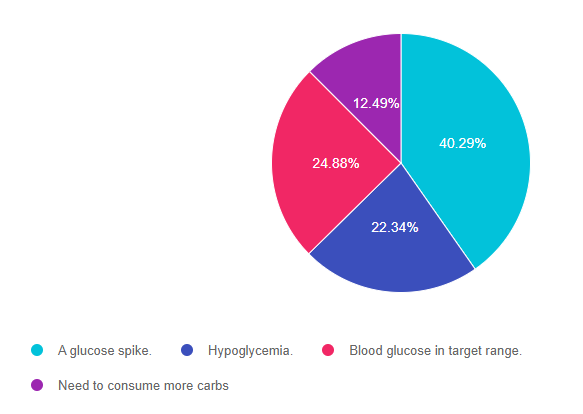
As shown above, the most common choice was option 1, the second most common answer was option 3, then option 2, and then finally option 4.
Getting to the Best Answer
Answer 1 is correct. 40.29% chose this answer, “A glucose spike.” Great job, this is the best answer! Even though MJ gave 3 units of bolus insulin to cover the carbs from the potato, there will be a secondary glucose spike about 3 hours later from the meat protein and the sour cream. There is a growing understanding (as noted in ADA Standard 5) that people with type 1 diabetes need to not only cover for carbs in the meal, but many times they need to include a small amount of bolus insulin to cover for high fat and protein sources. The delayed post meal glucose elevation is secondary to gluconeogenesis as their body converts some of the digested fat and protein into glucose. For people using insulin pump, they can use dual wave bolus, so they get some of the bolus initially and the rest a few hours later to coincide with the second glucose spike. People on insulin injections could also inject a small amount as they see their secondary glucose rising as protein and fat impact blood sugar levels.
Answer 2 is incorrect. 22.34% of you chose this answer, “Hypoglycemia.” This is a juicy answer, but the 3 units is just the right amount to cover for the potato, veggies and salad. Plus, with the additional protein and fat consumption, MJ is unlikely to experience hypoglycemia.
Answer 3 is incorrect. 24.88% of respondents chose this answer, “Blood glucose in target range.” MJ blood sugar could be in target range one to two hours post meal, but given the additional consumption of 5 ounces of protein plus sour cream, it is likely that around hour three, MJ will experience a glucose spike.
Finally, Answer 4 is incorrect. 12.49% chose this answer, “Need to consume more carbs.” This is a juicy answer, but the 3 units is just the right amount to cover for the potato, veggies and salad. Plus, with the additional protein and fat consumption, MJ is not likely to see blood sugar drop to the point where they would need to consume more carbs.
Want to read more about his topic?
Beyond Carbohydrate Counting: Utilizing Nutrition Factors to Optimize Insulin Dosing | On the Cutting Edge| 2021 Volume 42 | No 4 – Subscription only
Benefit of supplementary fat plus protein counting as compared with conventional carbohydrate counting for insulin bolus calculation in children with pump therapy – Article
We hope you appreciate this week’s rationale! Thank you so much for taking the time to answer our Question of the Week and participate in this important learning activity!
Want to learn more about this topic?
Join us for our Virtual DiabetesEd Specialist Conference
30+ CEs | April 13-15, 2022

Whether you are new to diabetes or a seasoned expert, you’ll benefit from this virtual conference with the latest research plus critical content that you can immediately apply to your clinical practice.
If you are seeking a state-of-the-art review of current diabetes care, this course is for you. Our team has been fine-tuning this course for over fifteen years, and we know what you need. This program can also be a great addition to your CDCES or BC-ADM exam study plan.
Download Course Schedule | Download Course Flyer
Join us LIVE for this Virtual Course and enjoy a sense of community!
Team of expert faculty includes:
- Diana Isaacs, PharmD, BCPS, BC-ADM, BCACP, CDCES – Educator of the Year, 2020
- Coach Beverly Thomassian, RN, MPH, CDCES, BC-ADM
- Ashley LaBrier, MS, RD, CDCES, Diabetes Program Coordinator
Download Course Schedule | Download Course Flyer
Two Registration Options
Virtual DiabetesEd Specialist Conference Deluxe | 30+ CEs
Deluxe Option for $499: Virtual Program includes:
- Q & A Session with the instructor after each webinar.
- LIVE Presentations by our team of experts.
- State of the art review of current diabetes care and technology.
- Resources for each session.
- Access to free podcasts and video recordings within a week of each live session for one year.
Deluxe Version includes Syllabus, Standards and Swag*:
- Diabetes Educator Course 2022 Syllabus Hard Copy – over 100 pages -This spiral-bound workbook contains the printed version of all of the instructor’s slides.
- ADA 2022 Standards of Care Book -The ADA Standards of Medical Care in Diabetes is a key resource for healthcare professionals involved in diabetes care, education, and support.
- DiabetesEd Services highlighters, Medication PocketCard, Tote Bag and Pen
Virtual DiabetesEd Specialist Conference Basic | 30+ CEs
Deluxe Option for $499: Virtual Program includes:
- Q & A Session with the instructor after each webinar.
- LIVE Presentations by our team of experts.
- State of the art review of current diabetes care and technology.
- Resources for each session.
- Access to free podcasts and video recordings within a week of each live session for one year.
Don’t worry if you can’t make it live. Your registration guarantees access to the recorded version in the Online University.
All hours earned count toward your CDCES Accreditation Information
Sign up for Diabetes Blog Bytes – we post one daily Blog Byte from Monday to Friday. And of course, Tuesday is our Question of the Week. It’s Informative and FREE! Sign up below!
The use of DES products does not guarantee the successful passage of the CDCES exam. CBDCE does not endorse any preparatory or review materials for the CDCES exam, except for those published by CBDCE.
Rationale of the Week | JR asks you; What is the Coefficient of Variation?

For last week’s practice question, we quizzed test takers on the coefficient of variation. 85% of respondents chose the best answer. We want to share this important updated information, so you can pass it on to people living with diabetes and your colleagues, plus prepare for exam success!
Before we start though, if you don’t want any spoilers and haven’t tried the question yet, you can answer below: Answer Question
Question: You are reviewing an ambulatory glucose profile with JR, a 27-year-old on an insulin pump. Time in range is 59% and the coefficient of variation is 46%. JR asks you to explain the coefficient of variation. What is the most helpful response?
Answer Choices:
- The amount of time blood glucose is at least one standard deviation below target.
- A statistic that summarizes if you are taking sufficient daily insulin based on basal rates.
- Great question that we can address later. Let’s focus on improving time in range first.
- It reflects how much your glucose levels fluctuate above and below target range.
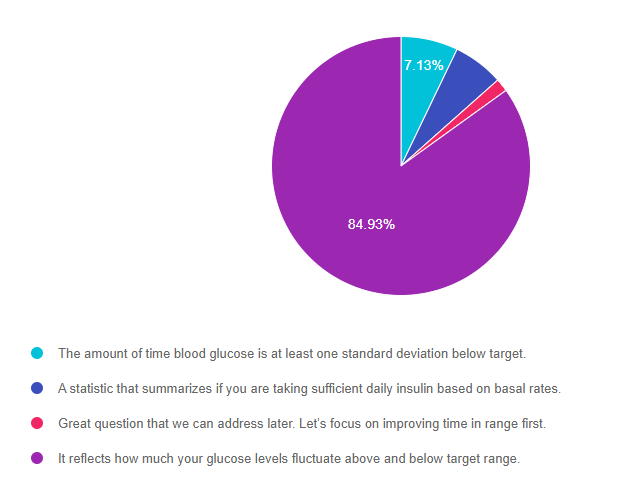
As shown above, the most common choice was option 4, the second most common answer was option 1, then option 2, and then finally option 3.
Getting to the Best Answer
Answer 1 is incorrect. 7.13% chose this answer, “The amount of time blood glucose is at least one standard deviation below target.” This is a juicy answer and is tempting. However, the coefficient of variation isn’t looking at only the below target blood glucose levels. It reflects how much glucose levels fluctuate above and below target range.
Answer 2 is incorrect. 6.31% of you chose this answer, “A statistic that summarizes if you are taking sufficient daily insulin based on basal rates.” Basal insulin dosing can affect glucose levels over night and between meals. But both the basal and bolus insulin affect the coefficient of variation which reflects how much the glucose levels are fluctuating above and below target range.
Answer 3 is incorrect. 1.63% of respondents chose this answer, “Great question that we can address later. Let’s focus on improving time in range first.” Time in range is important to discuss, however when using a person centered approach, we start with the topic that is most important to the person first.
Finally, Answer 4 is correct. 84.93% chose this answer, “It reflects how much your glucose levels fluctuate above and below target range.” GREAT JOB. 85% of you chose the best answer. When looking at the Ambulatory Glucose Profile, the shaded area reveals how much the glucose is fluctuating above and below target range. The goal for coefficient of variation (CV) is less than 36%, which is associated with a higher percentage of time in range.
CV is a fancy term for a simple calculation: dividing the SD by the mean glucose and multiplying by 100 to get a percentage. For example, if the SD is 50 mg/dl, and the average glucose is 150 mg/dl, then you divide 50 by 150, multiply by 100, and you get a CV of 33%.
Why use CV instead of SD? SD is highly influenced by the mean glucose – someone with a higher mean glucose will have a higher SD. This division helps “correct” and normalize glucose variability, allowing for a single variability goal (less than 36%) that applies to people with different mean glucose levels.
We hope you appreciate this week’s rationale! Thank you so much for taking the time to answer our Question of the Week and participate in this important learning activity!
Want to learn more about diabetes technology?
Join our expert speaker, Diana Isaacs, PharmD, BCPS, BC-ADM, BCACP, CDCES, who will be delving into diabetes technology
Virtual DiabetesEd Specialist Conference
30+ CEs | April 13-15, 2022

Whether you are new to diabetes or a seasoned expert, you’ll benefit from this virtual conference with the latest research plus critical content that you can immediately apply to your clinical practice.
If you are seeking a state-of-the-art review of current diabetes care, this course is for you. Our team has been fine-tuning this course for over fifteen years, and we know what you need. This program can also be a great addition to your CDCES or BC-ADM exam study plan.
Download Course Schedule | Download Course Flyer
Join us LIVE for this Virtual Course and enjoy a sense of community!
Team of expert faculty includes:
- Diana Isaacs, PharmD, BCPS, BC-ADM, BCACP, CDCES – Educator of the Year, 2020
- Coach Beverly Thomassian, RN, MPH, CDCES, BC-ADM
- Ashley LaBrier, MS, RD, CDCES, Diabetes Program Coordinator
Download Course Schedule | Download Course Flyer
Two Registration Options
Virtual DiabetesEd Specialist Conference Deluxe | 30+ CEs
Deluxe Option for $499: Virtual Program includes:
- Q & A Session with the instructor after each webinar.
- LIVE Presentations by our team of experts.
- State of the art review of current diabetes care and technology.
- Resources for each session.
- Access to free podcasts and video recordings within a week of each live session for one year.
Deluxe Version includes Syllabus, Standards and Swag*:
- Diabetes Educator Course 2022 Syllabus Hard Copy – over 100 pages -This spiral-bound workbook contains the printed version of all of the instructor’s slides.
- ADA 2022 Standards of Care Book -The ADA Standards of Medical Care in Diabetes is a key resource for healthcare professionals involved in diabetes care, education, and support.
- DiabetesEd Services highlighters, Medication PocketCard, Tote Bag and Pen
Virtual DiabetesEd Specialist Conference Basic | 30+ CEs
Deluxe Option for $499: Virtual Program includes:
- Q & A Session with the instructor after each webinar.
- LIVE Presentations by our team of experts.
- State of the art review of current diabetes care and technology.
- Resources for each session.
- Access to free podcasts and video recordings within a week of each live session for one year.
Don’t worry if you can’t make it live. Your registration guarantees access to the recorded version in the Online University.
All hours earned count toward your CDCES Accreditation Information
Sign up for Diabetes Blog Bytes – we post one daily Blog Byte from Monday to Friday. And of course, Tuesday is our Question of the Week. It’s Informative and FREE! Sign up below!
The use of DES products does not guarantee the successful passage of the CDCES exam. CBDCE does not endorse any preparatory or review materials for the CDCES exam, except for those published by CBDCE.
Rationale of the Week | The new “F” Word

This year, the ADA Standards focused on the importance of fiber. Since fiber intake is so important to our health, we decided to deem it the new “F” word for 2022. To highlight this under-consumed nutrient, we quizzed test takers on the goal of fiber intake. 70% of respondents chose the best answer. We want to share this important updated information, so you can pass it on to people living with diabetes and your colleagues, plus prepare for exam success!
Before we start though, if you don’t want any spoilers and haven’t tried the question yet, you can answer below: Answer Question
Question: AR has type 2 diabetes, is on metformin 1000mg BID, has a UACR of 28 mg/g and a GFR of 62. AR is struggling with constipation. What are the ADA Fiber Intake Recommendations?
Answer Choices:
- 14 grams of fiber for every 1000 k/cal
- Goal is to consume about 55 grams of fiber a day
- Eat fiber at least three times a day
- Try to consume 16 oz’s legumes/ day
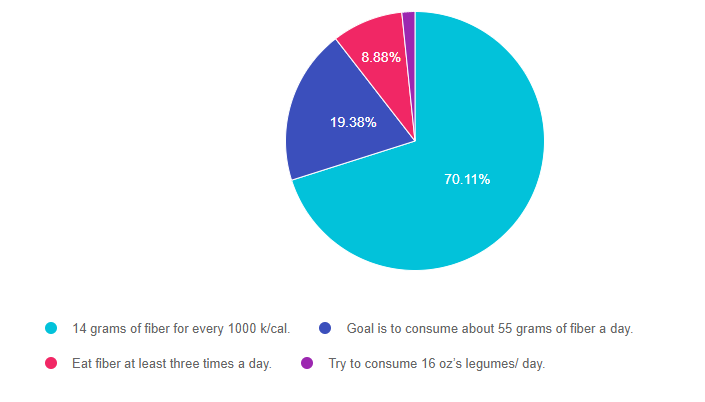
As shown above, the most common choice was option 1, the second most common answer was option 2, then option 3, and then finally option 4.
Getting to the Best Answer

Answer 1 is correct. 70.11% chose this answer, “14 grams of fiber for every 1000 k/cal.” YES, GREAT JOB. This is the best answer based on the ADA Standards of Care and national nutrition guidelines. The daily goal is to consume about 30gms of fiber a day. Yet, most Americans only eat about half that amount. Approximately 70% of the food consumed in the U.S. is processed. Processed and fast foods are notorious for low fiber content. Fiber intake is associated with better overall health, improved longevity, and happier gut bacteria. By increasing intake of fresh fruit, legumes, vegetables, popcorn, avocados, whole grains, and nuts, we would all feel a little bit better.
Answer 2 is incorrect. 19.38% of you chose this answer, “Goal is to consume about 55 grams of fiber a day.” This is a juicy answer, but a little ambitious. The daily goal is to consume about 30gms of fiber a day. Yet, most Americans only eat about half that amount.
Answer 3 is incorrect. 8.88% of respondents chose this answer, “Eat fiber at least three times a day.” Eating fiber at each meal is a great idea, but the goal is to consume at least 30gms a day.
Finally, Answer 4 is incorrect. 1.63% chose this answer, “Try to consume 16 oz’s legumes/ day.” While legumes are very high in fiber (16 ounces of beans, packs 70gms of fiber), the goal is to consume 30gms from whatever sources of fiber the individual enjoys most.
We hope you appreciate this week’s rationale! Thank you so much for taking the time to answer our Question of the Week and participate in this important learning activity!
Want to learn more about this topic?
Join our Virtual DiabetesEd Specialist Conference
30+ CEs | April 13-15, 2022

Whether you are new to diabetes or a seasoned expert, you’ll benefit from this virtual conference with the latest research plus critical content that you can immediately apply to your clinical practice.
If you are seeking a state-of-the-art review of current diabetes care, this course is for you. Our team has been fine-tuning this course for over fifteen years, and we know what you need. This program can also be a great addition to your CDCES or BC-ADM exam study plan.
Download Course Schedule | Download Course Flyer
Join us LIVE for this Virtual Course and enjoy a sense of community!
Team of expert faculty includes:
- Diana Isaacs, PharmD, BCPS, BC-ADM, BCACP, CDCES – Educator of the Year, 2020
- Coach Beverly Thomassian, RN, MPH, CDCES, BC-ADM
- Ashley LaBrier, MS, RD, CDCES, Diabetes Program Coordinator
Download Course Schedule | Download Course Flyer
Two Registration Options
Virtual DiabetesEd Specialist Conference Deluxe | 30+ CEs
Deluxe Option for $499: Virtual Program includes:
- Q & A Session with the instructor after each webinar.
- LIVE Presentations by our team of experts.
- State of the art review of current diabetes care and technology.
- Resources for each session.
- Access to free podcasts and video recordings within a week of each live session for one year.
Deluxe Version includes Syllabus, Standards and Swag*:
- Diabetes Educator Course 2022 Syllabus Hard Copy – over 100 pages -This spiral-bound workbook contains the printed version of all of the instructor’s slides.
- ADA 2022 Standards of Care Book -The ADA Standards of Medical Care in Diabetes is a key resource for healthcare professionals involved in diabetes care, education, and support.
- DiabetesEd Services highlighters, Medication PocketCard, Tote Bag and Pen
Virtual DiabetesEd Specialist Conference Basic | 30+ CEs
Deluxe Option for $499: Virtual Program includes:
- Q & A Session with the instructor after each webinar.
- LIVE Presentations by our team of experts.
- State of the art review of current diabetes care and technology.
- Resources for each session.
- Access to free podcasts and video recordings within a week of each live session for one year.
Don’t worry if you can’t make it live. Your registration guarantees access to the recorded version in the Online University.
All hours earned count toward your CDCES Accreditation Information
Sign up for Diabetes Blog Bytes – we post one daily Blog Byte from Monday to Friday. And of course, Tuesday is our Question of the Week. It’s Informative and FREE! Sign up below!
The use of DES products does not guarantee the successful passage of the CDCES exam. CBDCE does not endorse any preparatory or review materials for the CDCES exam, except for those published by CBDCE.
Rationale of the Week | How do they calculate UACR?

We quizzed test takers on the urinary albumin creatinine ratio. 59% of respondents chose the best answer. We want to share this important updated information, so you can pass it on to people living with diabetes and your colleagues, plus prepare for exam success!
Before we start though, if you don’t want any spoilers and haven’t tried the question yet, you can answer below: Answer Question
Question: What best describes how to measure urinary albumin creatinine ratio?
Answer Choices:
- Divide blood creatinine results with urinary albumin secretion rate.
- Collect 24-hour urine sample and add alkaline solution to determine albumin ratio quantity.
- Draw a fasting blood sample to determine ratio of creatinine in grams to albumin in milligrams.
- Divide urinary albumin concentration in milligrams by creatinine concentration in grams.
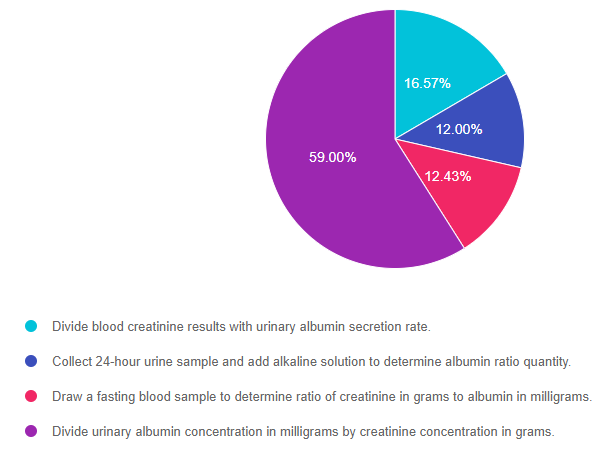
As shown above, the most common choice was option 4, the second most common answer was option 1, then option 3, and then finally option 2.
Getting to the Best Answer
Answer 1 is incorrect. 16.57% chose this answer, “Divide blood creatinine results with urinary albumin secretion rate.” This is a juicy answer! To calculate UACR, the lab uses albumin and creatinine results from the urine only. And since it is a ratio, they divide the urine albumin levels by the urine creatinine to get the result. Please see our blog From Dipsticks to GFR – How to Evaluate Kidney Function for a detailed explanation.
Answer 2 is incorrect. 12.00%% of you chose this answer, “Collect 24-hour urine sample and add alkaline solution to determine albumin ratio quantity.” In the old days, we would collect a 24 urine samples to evaluate kidney health. However, since the spot urine albumin /creatinine ratio is so accurate, we don’t need to do the cumbersome 24-hour collection to determine UACR. Now we can evaluate UACR using a spot collection (dipstick) or lab evaluation of urine. Please see our blog From Dipsticks to GFR – How to Evaluate Kidney Function for a detailed explanation.
Answer 3 is incorrect. 12.43% of respondents chose this answer, “Draw a fasting blood sample to determine the ratio of creatinine in grams to albumin in milligrams.” To calculate UACR, the lab uses albumin and creatinine results from the urine only. And since it is a ratio, they divide the urine albumin levels by the urine creatinine to get the result. No fasting is required for this test. Please see our blog From Dipsticks to GFR – How to Evaluate Kidney Function for a detailed explanation.
Finally, Answer 4 is correct. 59.00% chose this answer, “Divide urinary albumin concentration in milligrams by creatinine concentration in grams.” GREAT JOB. You chose the best answer. Urinary Albumin Creatinine Ratio (UACR) is the ratio of urine albumin to urine creatinine. The UACR is usually already calculated on the lab report,
To determine the UACR, you divide urine albumin by creatinine, then convert it to mg/g. The reason this value is reported as a ratio as opposed to just urine albumin is to account for the concentration and hydration status of the individual which improves accuracy.
UACR is an important measure of kidney health and the goal is to measure it yearly and if elevated, more frequently.
Testing for UACR is fairly easy. The ADA has approved using a urine dipstick or a urine sample to calculate the UACR, However, according to the standards, two of three tests need to be positive to confirm diagnosis within a 3 to 6 month period before confirming a diagnosis of moderate or severe albuminuria. Exercise within 24 h, infection, fever, congestive heart failure, marked hyperglycemia, menstruation, and marked hypertension may elevate UACR independently of kidney damage. Please see our blog From Dipsticks to GFR – How to Evaluate Kidney Function for a detailed explanation.
We hope you appreciate this week’s rationale! Thank you so much for taking the time to answer our Question of the Week and participate in this important learning activity!
Want to learn more about this topic?
Join our Virtual DiabetesEd Specialist Conference
30+ CEs | April 13-15, 2022

Whether you are new to diabetes or a seasoned expert, you’ll benefit from this virtual conference with the latest research plus critical content that you can immediately apply to your clinical practice.
If you are seeking a state-of-the-art review of current diabetes care, this course is for you. Our team has been fine-tuning this course for over fifteen years, and we know what you need. This program can also be a great addition to your CDCES or BC-ADM exam study plan.
Download Course Schedule | Download Course Flyer
Join us LIVE for this Virtual Course and enjoy a sense of community!
Team of expert faculty includes:
- Diana Isaacs, PharmD, BCPS, BC-ADM, BCACP, CDCES – Educator of the Year, 2020
- Coach Beverly Thomassian, RN, MPH, CDCES, BC-ADM
- Ashley LaBrier, MS, RD, CDCES, Diabetes Program Coordinator
Two Registration Options
Virtual DiabetesEd Specialist Conference Deluxe | 30+ CEs
Deluxe Option for $499: Virtual Program includes:
- Q & A Session with the instructor after each webinar.
- LIVE Presentations by our team of experts.
- State of the art review of current diabetes care and technology.
- Resources for each session.
- Access to free podcasts and video recordings within a week of each live session for one year.
Deluxe Version includes Syllabus, Standards and Swag*:
- Diabetes Educator Course 2022 Syllabus Hard Copy – over 100 pages -This spiral-bound workbook contains the printed version of all of the instructor’s slides.
- ADA 2022 Standards of Care Book -The ADA Standards of Medical Care in Diabetes is a key resource for healthcare professionals involved in diabetes care, education, and support.
- DiabetesEd Services highlighters, Medication PocketCard, Tote Bag and Pen
Virtual DiabetesEd Specialist Conference Basic | 30+ CEs
Deluxe Option for $499: Virtual Program includes:
- Q & A Session with the instructor after each webinar.
- LIVE Presentations by our team of experts.
- State of the art review of current diabetes care and technology.
- Resources for each session.
- Access to free podcasts and video recordings within a week of each live session for one year.
Don’t worry if you can’t make it live. Your registration guarantees access to the recorded version in the Online University.
All hours earned count toward your CDCES Accreditation Information
Sign up for Diabetes Blog Bytes – we post one daily Blog Byte from Monday to Friday. And of course, Tuesday is our Question of the Week. It’s Informative and FREE! Sign up below!
The use of DES products does not guarantee the successful passage of the CDCES exam. CBDCE does not endorse any preparatory or review materials for the CDCES exam, except for those published by CBDCE.
Rationale of the Week | Healthy Kidney Labs?

We quizzed test takers on kidney function. 81.64% of respondents chose the best answer. We want to share this important updated information, so you can pass it on to people living with diabetes and your colleagues, plus prepare for exam success!
Before we start though, if you don’t want any spoilers and haven’t tried the question yet, you can answer below: Answer Question
Question: Evaluating kidney function is important to determine the most beneficial treatment interventions. Which of the following measurements would indicate that JR has healthy kidney function?
Answer Choices:
- Urinary albumin creatinine ratio of 30-299 mg/g with GFR of 45.
- GFR of 60 or greater and urinary albumin creatinine ratio of 2 mg/g.
- Urinary albumin creatinine ratio less than 30 mg/g and GFR of 30-45.
- Creatinine of 1.5 and urinary albumin creatinine ratio of 300 mg/g or greater.
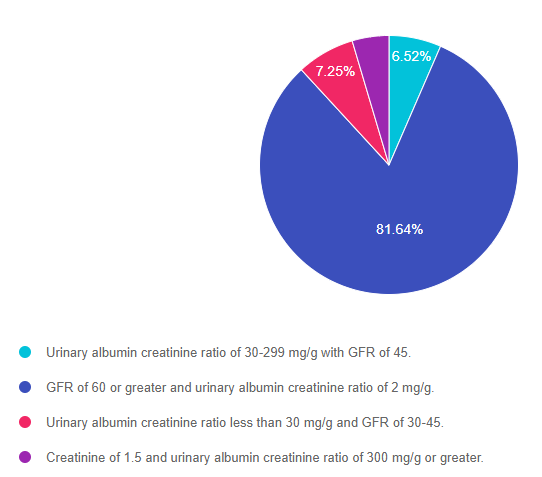
As shown above, the most common choice was option 2, the second most common answer was option 3, then option 1, and then finally option 4.
Getting to the Best Answer
Answer 1 is incorrect. 6.52% chose this answer, “Urinary albumin creatinine ratio of 30-299 mg/g with GFR of 45.” There are two major indicators of kidney health for people with diabetes, Glomerular Filtration Rate (GFR) and Urinary Albumin Creatinine Ratio (UACR). According to the ADA Standards, to have a healthy kidney function, JR would need a GFR of 60 or greater and a UACR less than 30 mg/g. Give that JR’s UACR is elevated at 30 mg/g or greater and the GFR is sluggish at 45, this is not the best answer.
Answer 2 is correct. 81.64%% of you chose this answer, “GFR of 60 or greater and urinary albumin creatinine ratio of 2 mg/g.” YES, GREAT JOB choosing the BEST answer. There are two major indicators of kidney health for people with diabetes, Glomerular Filtration Rate (GFR) and Urinary Albumin Creatinine Ratio (UACR). According to the ADA Standards, to have a healthy kidney function, JR would need a GFR of 60 or greater and a UACR less than 30 mg/g. Since JR meets both of these criteria, we can rest well knowing JR’s kidneys are healthy and flowing.
Answer 3 is incorrect. 7.25% of respondents chose this answer, “Urinary albumin creatinine ratio less than 30 mg/g and GFR of 30-45.” There are two major indicators of kidney health for people with diabetes, Glomerular Filtration Rate (GFR) and Urinary Albumin Creatinine Ratio (UACR). According to the ADA Standards, to have a healthy kidney function, JR would need a GFR of 60 or greater and a UACR less than 30 mg/g. Even though JR’s UACR is less than 30mg/g, the GFR is sluggish at 30-45. For this reason, this is not the best answer.
Finally, Answer 4 is incorrect. 4.59% chose this answer, “Creatinine of 1.5 and urinary albumin creatinine ratio of 300 mg/g or greater.” There are two major indicators of kidney health for people with diabetes, Glomerular Filtration Rate (GFR) and Urinary Albumin Creatinine Ratio (UACR). According to the ADA Standards, to have a healthy kidney function, JR would need a GFR of 60 or greater and a UACR less than 30 mg/g. In this response, we only know the creatinine level (which is elevated), but no GFR is calculated. In addition, the UACR is very elevated at 300 mg/g. For these reasons, this is not the best answer.
We hope you appreciate this week’s rationale! Thank you so much for taking the time to answer our Question of the Week and participate in this important learning activity!
Want to learn more about this topic?
Join our Virtual DiabetesEd Specialist Conference
30+ CEs | April 13-15, 2022

Whether you are new to diabetes or a seasoned expert, you’ll benefit from this virtual conference with the latest research plus critical content that you can immediately apply to your clinical practice.
If you are seeking a state-of-the-art review of current diabetes care, this course is for you. Our team has been fine-tuning this course for over fifteen years, and we know what you need. This program can also be a great addition to your CDCES or BC-ADM exam study plan.
Download Course Schedule | Download Course Flyer
Join us LIVE for this Virtual Course and enjoy a sense of community!
Team of expert faculty includes:
- Diana Isaacs, PharmD, BCPS, BC-ADM, BCACP, CDCES – Educator of the Year, 2020
- Coach Beverly Thomassian, RN, MPH, CDCES, BC-ADM
- Ashley LaBrier, MS, RD, CDCES, Diabetes Program Coordinator
Two Registration Options
Virtual DiabetesEd Specialist Conference Deluxe | 30+ CEs
Deluxe Option for $499: Virtual Program includes:
- Q & A Session with the instructor after each webinar.
- LIVE Presentations by our team of experts.
- State of the art review of current diabetes care and technology.
- Resources for each session.
- Access to free podcasts and video recordings within a week of each live session for one year.
Deluxe Version includes Syllabus, Standards and Swag*:
- Diabetes Educator Course 2022 Syllabus Hard Copy – over 100 pages -This spiral-bound workbook contains the printed version of all of the instructor’s slides.
- ADA 2022 Standards of Care Book -The ADA Standards of Medical Care in Diabetes is a key resource for healthcare professionals involved in diabetes care, education, and support.
- DiabetesEd Services highlighters, Medication PocketCard, Tote Bag and Pen
Virtual DiabetesEd Specialist Conference Basic | 30+ CEs
Deluxe Option for $499: Virtual Program includes:
- Q & A Session with the instructor after each webinar.
- LIVE Presentations by our team of experts.
- State of the art review of current diabetes care and technology.
- Resources for each session.
- Access to free podcasts and video recordings within a week of each live session for one year.
Don’t worry if you can’t make it live. Your registration guarantees access to the recorded version in the Online University.
All hours earned count toward your CDCES Accreditation Information
Sign up for Diabetes Blog Bytes – we post one daily Blog Byte from Monday to Friday. And of course, Tuesday is our Question of the Week. It’s Informative and FREE! Sign up below!
The use of DES products does not guarantee the successful passage of the CDCES exam. CBDCE does not endorse any preparatory or review materials for the CDCES exam, except for those published by CBDCE.
Rationale of the Week | Who needs a CGM based on New ADA Standards?

We quizzed test takers on the new ADA 2022 Standards of Care for CGMs. 71% of respondents chose the best answer. We want to share this important updated information, so you can pass it on to people living with diabetes and your colleagues, plus prepare for exam success!
Before we start though, if you don’t want any spoilers and haven’t tried the question yet, you can answer below: Answer Question
Question: In the 2022 ADA Standards, there are updated indications for use of real-time continuous glucose monitoring or intermittently scanned continuous glucose monitoring. Based on the new guidelines, which one of the following individuals needs to be offered continuous glucose monitoring to manage their diabetes?
Answer Choices:
- AL, a 54-year-old on a sulfonylurea plus metformin.
- RT, a 68-year-old on basal insulin and an SGLT-2 Inhibitor.
- ZR, a 23-year-old with diabetes secondary to HIV retroviral therapy.
- AW, an 18-year-old with prediabetes.
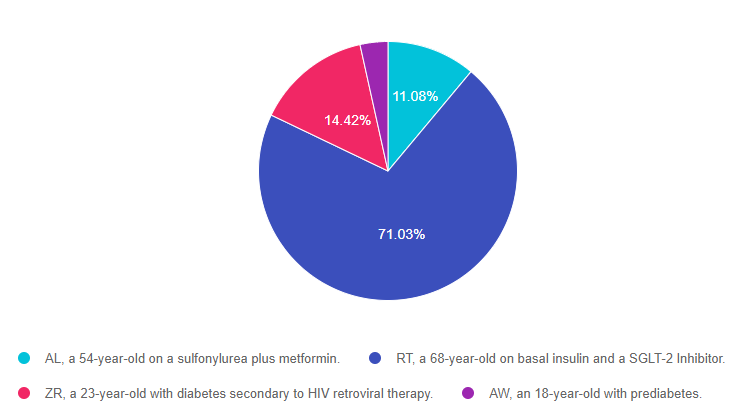
As shown above, the most common choice was option 2, the second most common answer was option 3, then option 1, and then finally option 4.
Getting to the Best Answer
Answer 1 is incorrect. 11.08% chose this answer, “AL, a 54-year-old on a sulfonylurea plus metformin.” This is a juicy answer, since AL is taking a medication that can cause hypoglycemia. This person would benefit from a glucose meter and instruction on the signs of hypoglycemia and what action to take if they have symptoms of low blood sugar. However, according to the standards, continuous glucose monitoring is not indicated for people with type 2 on orals. But knowing that insurance probably won’t cover a CGM, AL could choose to purchase (out of pocket) an intermittently scanning glucose meter to keep a close eye on their blood sugars.
Answer 2 is correct. 71.03%% of you chose this answer, “RT, a 68-year-old on basal insulin and an SGLT-2 Inhibitor.” GREAT JOB! According to the ADA Diabetes Technology Standard 7, “real-time continuous glucose monitoring or intermittently scanned continuous glucose monitoring can be used for diabetes management in adults with diabetes on basal insulin who are capable of using devices safely (either by themselves or with a caregiver). The choice of device should be made based on patient circumstances, desires, and needs.” In addition, this standard outlines that CGM should be offered during pregnancy and for youth and adults who are using insulin therapy to get glucose to target.
Answer 3 is incorrect. 14.42% of respondents chose this answer, “ZR, a 23-year-old with diabetes secondary to HIV retroviral therapy.” This answer is tempting. However, there is no indication in this answer that ZR is on insulin therapy and that is why it is not the best answer. The latest ADA Standards recommends CGM for adults on insulin therapy.
Finally, Answer 4 is incorrect. 3.47% chose this answer, “AW, an 18-year-old with prediabetes.” Good try. Currently, CGM is only recommended for people with diabetes on insulin or during pregnancy. Off the record, people with prediabetes might decide to purchase a blood glucose meter (if their insurance company doesn’t cover it) to keep an eye on their glucose levels and use the results as motivation to make lifestyle changes.
We hope you appreciate this week’s rationale! Thank you so much for taking the time to answer our Question of the Week and participate in this important learning activity!
Want to learn more about this topic?
Join our Virtual DiabetesEd Specialist Conference
30+ CEs | April 13-15, 2022

Whether you are new to diabetes or a seasoned expert, you’ll benefit from this virtual conference with the latest research plus critical content that you can immediately apply to your clinical practice.
If you are seeking a state-of-the-art review of current diabetes care, this course is for you. Our team has been fine-tuning this course for over fifteen years, and we know what you need. This program can also be a great addition to your CDCES or BC-ADM exam study plan.
Download Course Schedule | Download Course Flyer
Join us LIVE for this Virtual Course and enjoy a sense of community!
Team of expert faculty includes:
- Diana Isaacs, PharmD, BCPS, BC-ADM, BCACP, CDCES – Educator of the Year, 2020
- Coach Beverly Thomassian, RN, MPH, CDCES, BC-ADM
- Ashley LaBrier, MS, RD, CDCES, Diabetes Program Coordinator
Two Registration Options
Virtual DiabetesEd Specialist Conference Deluxe | 30+ CEs
Deluxe Option for $499: Virtual Program includes:
- Q & A Session with the instructor after each webinar.
- LIVE Presentations by our team of experts.
- State of the art review of current diabetes care and technology.
- Resources for each session.
- Access to free podcasts and video recordings within a week of each live session for one year.
Deluxe Version includes Syllabus, Standards and Swag*:
- Diabetes Educator Course 2022 Syllabus Hard Copy – over 100 pages -This spiral-bound workbook contains the printed version of all of the instructor’s slides.
- ADA 2022 Standards of Care Book -The ADA Standards of Medical Care in Diabetes is a key resource for healthcare professionals involved in diabetes care, education, and support.
- DiabetesEd Services highlighters, Medication PocketCard, Tote Bag and Pen
Virtual DiabetesEd Specialist Conference Basic | 30+ CEs
Deluxe Option for $499: Virtual Program includes:
- Q & A Session with the instructor after each webinar.
- LIVE Presentations by our team of experts.
- State of the art review of current diabetes care and technology.
- Resources for each session.
- Access to free podcasts and video recordings within a week of each live session for one year.
Don’t worry if you can’t make it live. Your registration guarantees access to the recorded version in the Online University.
All hours earned count toward your CDCES Accreditation Information
Sign up for Diabetes Blog Bytes – we post one daily Blog Byte from Monday to Friday. And of course, Tuesday is our Question of the Week. It’s Informative and FREE! Sign up below!
The use of DES products does not guarantee the successful passage of the CDCES exam. CBDCE does not endorse any preparatory or review materials for the CDCES exam, except for those published by CBDCE.
Rationale of the Week | With New Guidelines, who needs testing for hyperglycemia?

We quizzed test takers on the new ADA 2022 Standards of Care for Hyperglycemia. 39% of respondents chose the best answer. We want to share this important updated information, so you can pass it on to people living with diabetes and your colleagues, plus prepare for exam success!
Before we start though, if you don’t want any spoilers and haven’t tried the question yet, you can answer below: Answer Question
Question: Based on the 2022 ADA Standards of Care and Screening Guidelines, which one of the following people would need to be tested for hyperglycemia?
Answer Choices:
- RJ, a 36-year-old with a BMI of 23
- LS, a 32-year-old with a history of gastritis
- JM, a 33-year-old who smokes a pack a day
- KT, a 34-year-old who has bilateral pedal edema

As shown above, the most common choice was option 1, the second most common answer was option 3, then option 4, and then finally option 2.
Getting to the Best Answer
Answer 1 is correct. 39.80% chose this answer, “RJ, a 36-year-old with a BMI of 23.” GREAT JOB. Given the increasing incidence of prediabetes and diabetes in younger populations, the ADA has adjusted their screening threshold. The old guidelines suggest screening everyone starting at age 45. The new recommendations state that everyone aged 35 or older needs to have their blood glucose level evaluated to find undiagnosed prediabetes or diabetes.
Testing methods for prediabetes or diabetes can include:
- A1c
- Fasting Plasma Glucose (FPG) or
- Oral Glucose Tolerance Test (OGTT)
By testing for elevated glucose levels at this younger age bracket, health care professionals can provide early intervention to slow progression from prediabetes to diabetes and provide immediate care to those with newly discovered diabetes.
Answer 2 is incorrect. 15.47% of you chose this answer, “LS, a 32-year-old with a history of gastritis.” Based on the ADA Standards, we wouldn’t screen this individual for two reasons. They are younger than 35 and their BMI does not meet the threshold of 25 or greater (it isn’t even listed). Gastritis also isn’t a commonly co-associated diabetes condition*.
Answer 3 is incorrect. 22.56% of respondents chose this answer, “JM, a 33-year-old who smokes a pack a day.” Based on the ADA Standards, we wouldn’t screen this individual for two reasons. They are younger than 35 and their BMI does not meet the threshold of 25 or greater (it isn’t even listed). Smoking has been show to increase insulin resistance, but the ADA doesn’t list it as a risk factor*.
Finally, Answer 4 is incorrect. 22.17% chose this answer, “KT, a 34-year-old who has bilateral pedal edema.” They are younger than 35 and their BMI does not meet the threshold of 25 or greater (it isn’t even listed). Pedal edema can be caused for a variety of reasons, but the ADA doesn’t list pedal edema as a risk factor*.
*Coach Bev note. It is appropriate to screen for hyperglycemia, even if an individual doesn’t meet this criteria, if a health care professional is worried that based on clinical presentation, that an individual is at risk for prediabetes or diabetes.
We hope you appreciate this week’s rationale! Thank you so much for taking the time to answer our Question of the Week and participate in this important learning activity!
Want to learn more about this topic?
Enroll in Our Standards of Care Intensive | Level 2
This bundle is specifically designed for healthcare professionals who want to learn more about the ADA Standards of Diabetes Care for their clinical practice or for those who are studying for the BC-ADM or the CDCES certification exam.
2022 Live Webinar Updates
- Recorded December 15, 2021 – Hyperglycemic Crises, DKA & HHS Standards | 1.0 CE
- Recorded December 21, 2021 – Assessing and Promoting Well-Being: From Population Health to a Person-Centered Approach Standards | 1.5 CEs
- February 3, 2022 – ADA Standards of Care | 2.0 CEs
- March 24, 2022 – Meds Management for Type 2 – 1.5 CEs
- March 29, 2022 – Lower Extremity Assessment 1.5 CEs
- April 26, 2022 – Microvascular Complications, Eye, Kidney Nerve Disease 1.5 CEs
- April 28, 2022 – Critical Assessment of Diabetes Patient 2.0 CEs
- May 10, 2022 – Cardiovascular Disease and Diabetes Standards 1.5 CEs
- May 12, 2022 – Older Adults and DIabetes 1.5 CEs
- May 17, 2022 – Tots to Teens – Diabetes Standards 1.5 CEs
- May 19, 2022 – Pregnancy and Diabetes 1.5 CEs
- May 26, 2022 – Hospital and Hyperglycemia 1.5 CEs
- July 21, 2022 – Setting up a Successful Diabetes Program 1.5 CEs
Don’t worry if you can’t make it live. Your registration guarantees access to the recorded version in the Online University.
All hours earned count toward your CDCES Accreditation Information
Intended Audience: A great course for healthcare professionals in the field of diabetes education looking for a straightforward explanation of identification and treatment of hyperglycemic crises.
Instructor: Beverly Thomassian RN, MPH, CDCES, BC-ADM is a working educator and a nationally recognized diabetes expert.
Sign up for Diabetes Blog Bytes – we post one daily Blog Byte from Monday to Friday. And of course, Tuesday is our Question of the Week. It’s Informative and FREE! Sign up below!
[yikes-mailchimp form=”1″]The use of DES products does not guarantee the successful passage of the CDCES exam. CBDCE does not endorse any preparatory or review materials for the CDCES exam, except for those published by CBDCE.
Rationale of the Week | New Standards for Kidney Disease

We quizzed test takers on the new ADA Standards of Care for Kidney Disease. 56% of respondents chose the best answer. We want to share this important info so you can pass it on to people living with diabetes and your colleagues, plus prepare for exam success!
Before we start though, if you don’t want any spoilers and haven’t tried the question yet, you can answer below: Answer Question
Question: Based on the 2022 ADA Standards of Care, which of the following is the most accurate statement regarding chronic kidney disease and risk management?
Answer Choices:
- Monitor kidney function twice yearly if urinary albumin is 300 or greater and/or if GFR is 30-60.
- For people with GFR less than 60, relax glucose target to prevent hypoglycemia.
- If GFR is less than 30 in an individual with diabetes, avoid use of SGLT-2 Inhibitors.
- For individuals with GFR less than 60, refer to RD to encourage low protein diet.

As shown above, the most common choice was option 1, the second most common answer was option 3, then option 2, and then finally option 4.
Getting to the Best Answer
Answer 1 is correct. 55.61% chose this answer, “Monitor kidney function twice yearly if urinary albumin is 300 or greater and/or if GFR is 30-60.” YES, GREAT JOB. Most of you chose the best answer for this new recommendation. Catching renal failure early can be life saving. Two big indicators of serious renal issues include proteinuria and a diminished GFR. Early interventions (including getting BG and BP to goal) and regular monitoring can protect kidneys for the long run.
Answer 2 is incorrect. 8.51% of you chose this answer, “If GFR is less than 30 in an individual with diabetes, avoid use of SGLT-2 Inhibitors.” This is a juicy answer. The GFR cut-offs for the SGLT-2s have been changing a lot over the past year. More research is showing that, in some cases, even with a GFR less than 30 (especially in the presence of proteinuria) SGLT-2s are indicated since they have a renal protective effect. See ADA Standard 11 on Chronic Kidney Disease for more info.
Answer 3 is incorrect. 28.05% of respondents chose this answer, “People with type 2 are less likely to experience diabetes complications than those with type 1 diabetes.” According the the National Kidney Foundation, “About 30 percent of people with Type 1 diabetes and 10 to 40 percent of those with Type 2 diabetes eventually experience kidney failure.” The most important message is to encourage people with diabetes to be actively involved in their treatment plan and advocate for best medical care to protect renal function.
Finally, Answer 4 is incorrect. 7.83% chose this answer, “For individuals with GFR less than 60, refer to RD to encourage low protein diet.” This is an outdated recommendation for over the past five years. The ADA recognized that the science does not support low protein diets as a protective intervention for those with renal disease. For people with nondialysis-dependent stage 3 or higher chronic kidney disease, dietary protein intake recommendation is 0.8 g/kg body weight per day.
We hope you appreciate this week’s rationale! Thank you so much for taking the time to answer our Question of the Week and participate in this important learning activity!
Want to learn more about this topic?
Enroll in Our Standards of Care Intensive | Level 2
This bundle is specifically designed for healthcare professionals who want to learn more about the ADA Standards of Diabetes Care for their clinical practice or for those who are studying for the BC-ADM or the CDCES certification exam.
2022 Live Webinar Updates
- Recorded December 15, 2021 – Hyperglycemic Crises, DKA & HHS Standards | 1.0 CE
- Recorded December 21, 2021 – Assessing and Promoting Well-Being: From Population Health to a Person-Centered Approach Standards | 1.5 CEs
- February 3, 2022 – ADA Standards of Care | 2.0 CEs
- March 24, 2022 – Meds Management for Type 2 – 1.5 CEs
- March 29, 2022 – Lower Extremity Assessment 1.5 CEs
- April 26, 2022 – Microvascular Complications, Eye, Kidney Nerve Disease 1.5 CEs
- April 28, 2022 – Critical Assessment of Diabetes Patient 2.0 CEs
- May 10, 2022 – Cardiovascular Disease and Diabetes Standards 1.5 CEs
- May 12, 2022 – Older Adults and DIabetes 1.5 CEs
- May 17, 2022 – Tots to Teens – Diabetes Standards 1.5 CEs
- May 19, 2022 – Pregnancy and Diabetes 1.5 CEs
- May 26, 2022 – Hospital and Hyperglycemia 1.5 CEs
- July 21, 2022 – Setting up a Successful Diabetes Program 1.5 CEs
Don’t worry if you can’t make it live. Your registration guarantees access to the recorded version in the Online University.
All hours earned count toward your CDCES Accreditation Information
Intended Audience: A great course for healthcare professionals in the field of diabetes education looking for a straightforward explanation of identification and treatment of hyperglycemic crises.
Instructor: Beverly Thomassian RN, MPH, CDCES, BC-ADM is a working educator and a nationally recognized diabetes expert.
Sign up for Diabetes Blog Bytes – we post one daily Blog Byte from Monday to Friday. And of course, Tuesday is our Question of the Week. It’s Informative and FREE! Sign up below!
[yikes-mailchimp form=”1″]The use of DES products does not guarantee the successful passage of the CDCES exam. CBDCE does not endorse any preparatory or review materials for the CDCES exam, except for those published by CBDCE.









